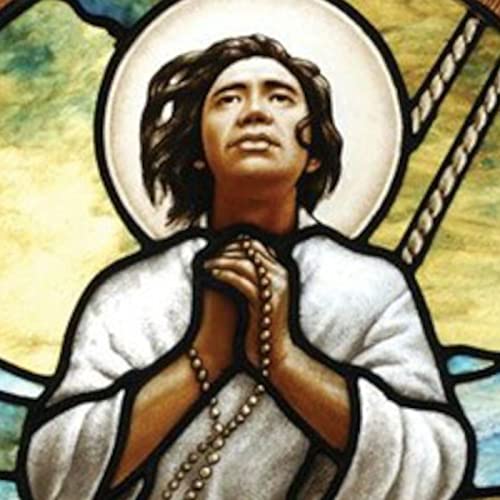September 28: Saint Lawrence Ruiz & Companions, Martyrs
c. 1600–1637
Optional Memorial; Liturgical Color: Red
Patron Saints of the Philippines
A married father remains unbroken under the cruelest torture
Many lesser-known faces in the deep audience of saints bask in the soft glow of sanctity emanating from the more prominent “marquee” saints standing on stage. In the Church’s calendar of saints, these more obscure observers of the principle action are often classified as “companions.” They can encompass dozens, or even hundreds, of men and women on a given feast day. Today’s saint, Lawrence Ruiz, is commemorated along with fifteen just such “companions,” in this case mostly missionary priests. Interestingly, Saint Lawrence is not the companion to the priests he died with. The priests, instead, are listed as Lawrence’s companions. The married Lawrence is on stage while his companion priest martyrs are in the audience.
Saint Lawrence was born of a Chinese father and a Philipino mother, both of whom were Catholic. Growing up in the Philippines, he served as an altar boy, was educated by Dominican priests, and belonged to a fraternal society dedicated to the Holy Rosary. Because he was an educated and careful writer in a largely illiterate culture, he became a clerk and a calligrapher. He married a woman named Rosario, and they had three children. He and his family lived an ordinary, secure, peaceful life of faith. As 1636 dawned, there was no reason to guess that Lawrence would continue living anything other than a quiet life focused on home and work. But then everything suddenly and drastically changed.
Lawrence was implicated, falsely, in the death of a Spaniard. It was a charge so serious he had to flee the Archipelago. Through his friendships with priests, he was invited to board a ship with three Dominicans, a Japanese priest, and a layman. In June of 1636, the small vessel sailed for Japan, a hornet’s nest buzzing with anti-Catholic persecution. The ship intended to land in a peaceful region devoid of persecution, but instead errantly docked in Okinawa at the worst possible moment. Feudal Japanese Shoguns were out for the blood of Catholics, and the missionaries walked right into their tight grip. They spent over a year in prison before, along with still more Catholic prisoners, they were marched to Nagasaki for the inevitable slur against their deepest beliefs.
The Japanese had devised torture techniques carefully calibrated to elicit maximum agony and the renunciation of the faith. On September 27, 1637, the prisoners had huge amounts of water poured down their throats, were covered with boards, and then stepped on by guards, forcing the water to spurt out of their mouths, noses, and ears. Then they were tightly bound, with one hand free in case they wanted to signal renunciation of the faith, and hung upside down over a pit. Heavy stones were tied to their bodies to draw blood more quickly down into their torsos and skulls. As the red liquid painfully pressurized their cranial sacs, the torturers strategically cut the victim’s heads to release the collected blood. This prevented the loss of consciousness and prolonged the throbbing pain. Amidst this anguish, no one broke. No one renounced their faith. No one cried out for relief. Mental images of mother and father, of smiling wife and children, of home, the fireplace, and warm embraces, did not prevail. It was God or death. Lawrence’s reputed last words were “I am a Catholic and wholeheartedly accept death for God; Had I a thousand lives, all these I would offer to God.”
As their chest cavities filled with blood, the victims hearts could pump no more. Lawrence suffocated to death within a day or two. Some of the priests did not succumb as quickly and were beheaded. Lawrence’s fifteen companions were Japanese, Spanish, French, and Italian priests; a few consecrated women; and laymen, almost all Dominicans. Their bodies were burned and their ashes scattered in the Pacific Ocean. Lawrence was beatified in 1981 in Manila, the first beatification performed outside the city of Rome. After a Philippina baby with hydrocephalus, or water on the brain, was cured through his intercession, Saint Lawrence was canonized by Pope Saint John Paul II in 1987. He is the protomartyr of the only Catholic nation in Asia, the Philippines.
Saint Lawrence, you were a married father yet forsook return to your earthly home to win a more glorious home in heaven. Help all fathers to be generous in quiet and in tumultuous times, to persevere in small things so they are able to display fortitude in great things.



